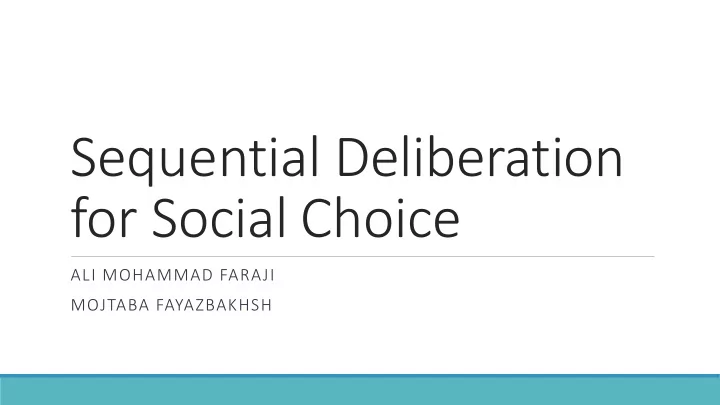

Sequential Deliberation for Social Choice ALI MOHAMMAD FARAJI MOJTABA FAYAZBAKHSH
Problem Statement Protocol for aggregation of Social preferences Difficulties: ◦ System designer may not be able to enumerate all the outcomes in the decision space ◦ Minifying the decision space: removing the social optimum ◦ Agents may not have rankings over the entire decision space ◦ Difficulty to implement most ordinal voting schemes in continuous spaces 2 /16
Problem Statement Premises: ◦ No need to formally articulate the entire decision space ◦ No need for every agent to report his ordinal ranking ◦ Agents can reason about their preferences ◦ Small groups can negotiate 3 /16
Background Bargaining Theory: ◦ Two-person bargaining: ◦ A game: A disagreement outcome and two agents who must cooperate to reach a decision ◦ Failure to cooperate: Adoption of the disagreement outcome ◦ Nash axioms: ◦ Pareto optimality ◦ Symmetry between agents ◦ Invariance with respect to affine transformations of utility ◦ Independence of irrelevant alternatives 4 /16
Background Bargaining Theory: ◦ Nash: Solution maximizing the Nash product is the unique solution satisfying the axioms ◦ If agent u has a bliss point p u , his disutility for an alternative a is d(p u , a) ◦ Subject to individual rationality: d(p v , o) ≤ d(p v ,a) and d(p u ,o) ≤ d(p u ,a) 5 /16
Background Social cost: 𝑇𝐷 𝑏 = 𝑒(𝑞𝑣, 𝑏) 𝑣∈𝑂 Distortion: 𝑇𝐷(𝑏) 𝐸𝑗𝑡𝑢𝑝𝑠𝑢𝑗𝑝𝑜 𝑏 = ∗ 𝑇𝐷(𝑏 ) 6 /16
Sequential pairwise deliberation 7 /16
General Metric Spaces The Distortion of sequential deliberation is at most 3 ◦ This bound is tight. ◦ The bound is quite pessimistic. 8 /16
Flexibility of Model Well defined and practical irrespective of an analytical model Generality and high level abstraction Regardless of the underlying decision space or mediator ’ s understanding of the space 9 /16
Median Graphs A median graph G(S, E) ◦ unweighted and undirected ◦ ∀ u, v, w ∈ S × S × S: ∃ a unique point that is common to the shortest paths. ◦ This point is the unique median of u, v, w. Trees, points on a line, hypercubes, grid graphs, etc. 10 /16
Nash Bargaining on Median Graphs Nash bargaining will select the median of bliss points of the two agents p u , p v and disagreement alternative a . The median maximizes Nash product and is closest to a . Recall: 11 /16
Hypercube Embedding For any median graph G = (S, E) , there is an isometric embedding φ : G → Q of G into a hypercube Q φ (Median(t, u, v)) = Median( φ (t), φ (u), φ (v)) the Distortion of sequential deliberation on G is at most the Distortion of sequential deliberation on φ (G) where each agent ’ s bliss point is φ (p u ) . 12 /16
Distortion of Sequential Deliberation As t → ∞ , the Distortion of sequential deliberation approaches 1.208 Convergence rate is: ◦ exponentially fast in t ◦ independent of |N|, |S|, a 1 The Distortion is at most 1.22 in at most 9 steps of deliberation! 13 /16
Proof Idea Hypercube embedding ◦ Dimension-wise analysis ◦ optimum social cost ◦ Median Defining a Markov chain ◦ Expected sequential deliberation social cost analysis 14 /16
Lower Bounds on Distortion ( I ): Any mechanism constrained to choose outcomes in bliss points has Distortion at least 3. ◦ Sequential deliberation dominates random dictatorship on every instance for median graphs. ◦ Deliberation do play a role in reducing Distortion ( II ): Any mechanism constrained to choose median of three points in bliss points must have Distortion at least 1.316. ◦ Oligarchy again is not well! 15 /16
ANY QUESTIONS? 16
Recommend
More recommend